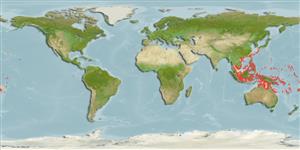>
Eupercaria/misc (Various families in series Eupercaria) >
Lutjanidae (Snappers) > Lutjaninae
Etymology: Lutjanus: Malay, ikan lutjan, name of a fish.
More on author: Lacepède.
Environment: milieu / climate zone / rango de profundidad / distribution range
Ecología
marino asociado a arrecife; rango de profundidad 3 - 50 m (Ref. 9710). Tropical; 35°N - 21°S, 93°E - 170°W
Western Pacific: Sumatra to Samoa, north to southern Japan. Apparently restricted to the western Pacific (Ref. 30829).
Tamaño / Peso / Age
Madurez: Lm ? range ? - ? cm
Max length : 35.0 cm TL macho / no sexado; (Ref. 48635); common length : 20.0 cm TL macho / no sexado; (Ref. 55)
Espinas dorsales (total) : 10 - 11; Radios blandos dorsales (total) : 13 - 14; Espinas anales: 3; Radios blandos anales: 8. Snout somewhat pointed. Eye large. Preorbital bone narrow, its width much less than eye diameter. Preopercular notch and knob well developed. Scale rows on back rising obliquely above lateral line. Generally pink or reddish, white or silvery below. Usually a series of ten to twelve stripes is on the side. Some specimens have black spot on the back below the anterior part of the soft dorsal fin.
Body shape (shape guide): fusiform / normal; Cross section: oval.
Adults inhabit coral reefs. Often seen in schools near outcrops or drop-offs, often with other species (Ref. 9710), of up to about 30 to 40 individuals. Small juveniles on shallow algae reef, often near freshwater run-offs (Ref. 48635). Feed on fishes, shrimps, crabs, other crustaceans, cephalopods and some planktonic items.
Life cycle and mating behavior
Madurez | Reproducción | Puesta | Huevos | Fecundidad | Larva
Allen, G.R., 1985. FAO Species Catalogue. Vol. 6. Snappers of the world. An annotated and illustrated catalogue of lutjanid species known to date. FAO Fish. Synop. 125(6):208 p. Rome: FAO. (Ref. 55)
IUCN Red List Status (Ref. 130435: Version 2025-1)
Threat to humans
Harmless
Human uses
Pesquerías: escaso valor comercial
Herramientas
Special reports
Download XML
Fuentes de Internet
Estimates based on models
Preferred temperature (Referencia
123201): 24.3 - 29, mean 28.2 °C (based on 542 cells).
Phylogenetic diversity index (Referencia
82804): PD
50 = 0.5000 [Uniqueness, from 0.5 = low to 2.0 = high].
Bayesian length-weight: a=0.01479 (0.00706 - 0.03101), b=2.97 (2.80 - 3.14), in cm total length, based on LWR estimates for this Genus-body shape (Ref.
93245).
Nivel trófico (Referencia
69278): 3.8 ±0.56 se; based on food items.
Generation time: 1.8 ( na - na) years. Estimated as median ln(3)/K based on 1
growth studies.
Resiliencia (Referencia
120179): Alto, población duplicada en un tiempo mínimo inferior a 15 meses (Preliminary K or Fecundity.).
Fishing Vulnerability (Ref.
59153): Low vulnerability (25 of 100).
🛈
Nutrients (Ref.
124155): Calcium = 48.7 [28.8, 77.0] mg/100g; Iron = 0.444 [0.285, 0.734] mg/100g; Protein = 18.3 [16.8, 19.7] %; Omega3 = 0.134 [0.089, 0.204] g/100g; Selenium = 56.7 [33.3, 99.0] μg/100g; VitaminA = 200 [38, 831] μg/100g; Zinc = 0.47 [0.35, 0.68] mg/100g (wet weight);
